1, Experimental purpose
1. Understand and master the jump principle of transfer instruction
2. Master the method of using call and ret instructions to realize subroutines, and understand and master the parameter transfer mode
3. Understand and master 80 × 25 color character mode display principle
4. Integrate addressing mode and assembly instructions to complete simple application programming
2, Experimental preparation
Review chapters 9-10 of the textbook:
Jump principle of transfer instruction
Usage of assembly instructions jmp, loop, jcxz, call, ret, retf
3, Experimental content
1. Experimental task 1
1 assume cs:code, ds:data 2 data segment 3 x db 1, 9, 3 4 len1 equ $ - x ; symbolic constants , $Refers to the offset address of the next data item. In this example, it is 3 5 y dw 1, 9, 3 6 len2 equ $ - y ; symbolic constants , $Refers to the offset address of the next data item. In this example, it is 9 7 data ends 8 code segment 9 start: 10 mov ax, data 11 mov ds, ax 12 mov si, offset x ; Take symbol x Corresponding offset address 0 -> si 13 mov cx, len1 ; From symbol x Number of consecutive byte data items at the beginning 3-> cx 14 mov ah, 2 15 s1:mov dl, [si] 16 or dl, 30h 17 int 21h 18 mov dl, ' ' 19 int 21h ; Output space 20 inc si 21 loop s1 22 mov ah, 2 23 mov dl, 0ah 24 int 21h ; Line feed 25 mov si, offset y ; Take symbol y Corresponding offset address 3 -> si 26 mov cx, len2/2 ; From symbol y Number of consecutive word data items started -> cx 27 mov ah, 2 28 s2:mov dx, [si] 29 or dl, 30h 30 int 21h 31 mov dl, ' ' 32 int 21h ; Output space 33 add si, 2 34 loop s2 35 mov ah, 4ch 36 int 21h 37 code ends 38 end start

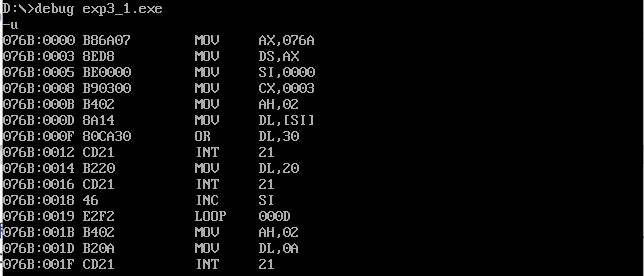
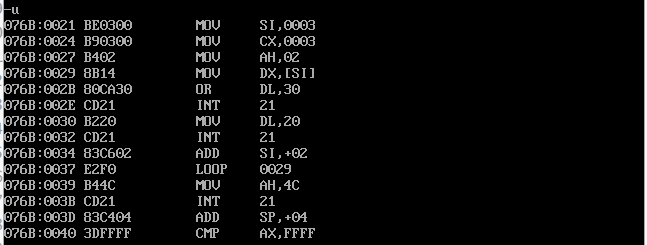
① line27, when the assembly instruction loop s1 jumps, it jumps according to the displacement. Check the machine code through debug disassembly and analyze the jump displacement? (the displacement value is answered in decimal) from the perspective of the CPU, explain how to calculate the offset address of the instruction after the jump label s1.
From 001B to 000D, the displacement is - 14 (decimal)
F2 is the complement of - 14
The loop instruction is a circular instruction. All circular instructions are short transfers. The IP modification range is - 128 ~ 127 (8 bits). The shift of the transfer is included in the corresponding machine code, not the destination address. Then the shifted 8-bit displacement = the address at the label - the address of the first byte after the loop instruction, i.e. 001B-000D. The 8-bit displacement is calculated by the compiler during compilation.
② line44. When the assembly instruction loop s2 jumps, it jumps according to the displacement. Check the machine code through debug disassembly and analyze the jump displacement? (the displacement value is answered in decimal) from the perspective of the CPU, explain how to calculate the offset address of the instruction after the jump label s2.
From 0039 to 0029, the displacement is - 16 (decimal)
F0 is the complement of - 16
The machine code format of the loop instruction is E2 offset (represented by 8 bits and complement)
The loop instruction is a circular instruction. All circular instructions are short transfers. The IP modification range is - 128 ~ 127 (8 bits). The shift of the transfer is included in the corresponding machine code, not the destination address. Then the shifted 8-bit displacement = the address at the label - the address of the first byte after the loop instruction, i.e. 0039-0029. The 8-bit displacement is calculated by the compiler during compilation, and the offset is represented by complement.
2. Experimental task 2
assume cs:code, ds:data data segment dw 200h, 0h, 230h, 0h data ends stack segment db 16 dup(0) stack ends code segment start: mov ax, data mov ds, ax mov word ptr ds:[0], offset s1 mov word ptr ds:[2], offset s2 mov ds:[4], cs mov ax, stack mov ss, ax mov sp, 16 call word ptr ds:[0] s1: pop ax call dword ptr ds:[2] s2: pop bx pop cx mov ah, 4ch int 21h code ends end start
① According to the jump principle of call instruction, it is analyzed theoretically that before the program executes to exit (line31), register (ax) =? Register (bx) =? Register (cx) =?
Execute call word ptr ds:[0], ds:[0] is the address of s1: 0021, and press IP:0021 into the stack. After executing pop ax, take out 0021 and assign it to ax.
Execute call dword ptr ds:[2], ds:[2] is the address of label s2: 0026, press CS: 076C and IP: 0026 into the stack, execute pop bx, take out 0026 and assign it to bx, execute pop cx, and take out 076C and assign it to cx
Therefore, theoretically, ax=0021,bx=0026,cx=076C
② Assemble and link the source program to get the executable program task2.exe. Use debug to observe and verify whether the debugging results are consistent with the theoretical analysis results.
See above



3. Experimental task 3
assume cs:code,ds:data data segment x db 99,72,85,63,89,97,55 len equ $- x data ends code segment start: mov ax, data mov ds, ax mov cx,10 mov si,0 s: mov ah,0 mov al,ds:[si] mov bl,10 div bl mov ds:[len+si],al ;Store the two digits of the number separately mov ds:[len+1+si],ah mov ah,2 ;int 21h Subfunction 2 of mov dl,ds:[len+si] add dl,30h ;Convert numbers from decimal to ASCII code int 21h ;Print mov ah,2 mov dl,ds:[len+1+si] add dl,30h int 21h mov ah,2 mov dl," " int 21h inc si loop s mov ah,4ch int 21h code ends end start
Test results:
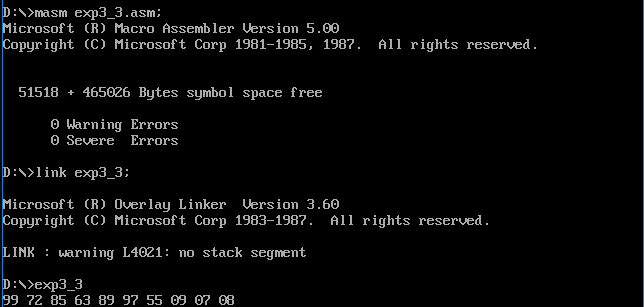
4. Experimental task 4
Write the 8086 assembly source program task4.asm, specify the color and line on the screen, and output the string on the screen. Requirements:
Write subroutine printStr
Function: display the string on the screen in the specified line and in the specified color
Entry parameters
The address of the first character of the string -- > ds: Si (where, the segment address of the segment where the string is located -- > DS, and the offset address of the starting address of the string -- > SI)
String length -- > CX
String color -- > bl
Specified line -- > BH (value: 0 ~ 24)
Outlet parameters: none;
In the main code, printStr is called twice to display the string in green on a black background at the top of the screen and in red on a black background at the bottom of the screen
Subroutine not used:
assume cs:code,ds:data data segment str db 'try' len equ $ - str data ends code segment start: mov ax,data mov ds,ax mov ax,0b800h mov es,ax mov cx,len mov si,0 mov bx,0000h ;first line s1: mov ah, 02h mov al,ds:[si] mov es:[bx],ax add bx,2 inc si loop s1 mov bx,0F00h ;Last line mov cx,len mov si,0 s2: mov al,ds:[si] mov ah,04h mov es:[bx],ax add bx,2 inc si loop s2 mov ax,4c00h int 21h code ends end
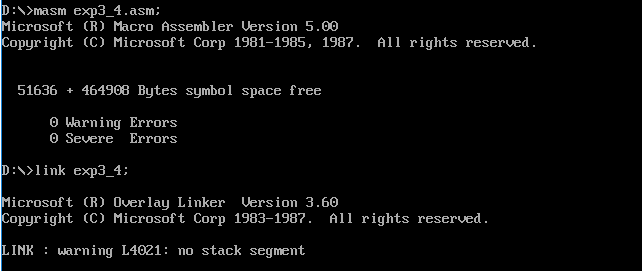
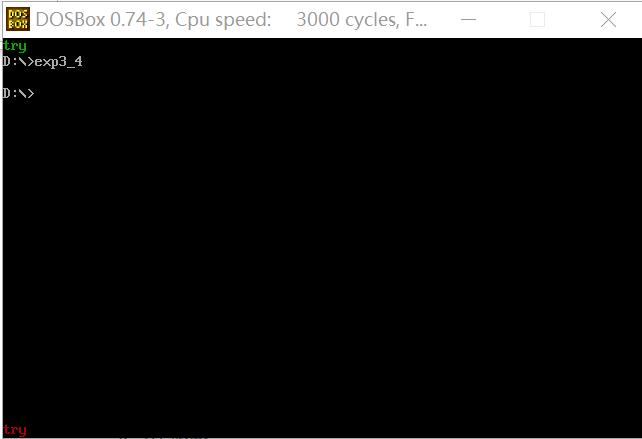
Using subroutines
assume cs:code,ds:data data segment str db 'try' len equ $ - str data ends code segment start: mov ax,data mov ds,ax mov ax,0b800h mov es,ax mov si, offset PrintStr mov bx,0000h ;first line mov ah, 02h call si mov si, offset PrintStr mov bx,0F00h ;Last line mov ah,04h call si mov ax,4c00h int 21h PrintStr: mov cx,len mov si,0 s: mov al,ds:[si] mov es:[bx],ax add bx,2 inc si loop s ret code ends end start
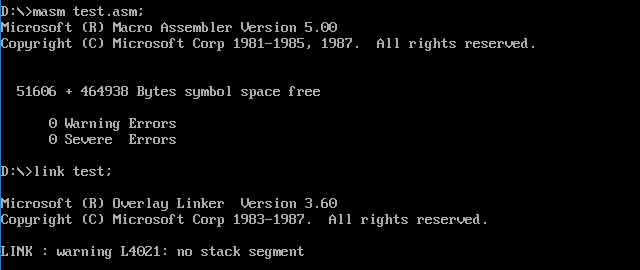
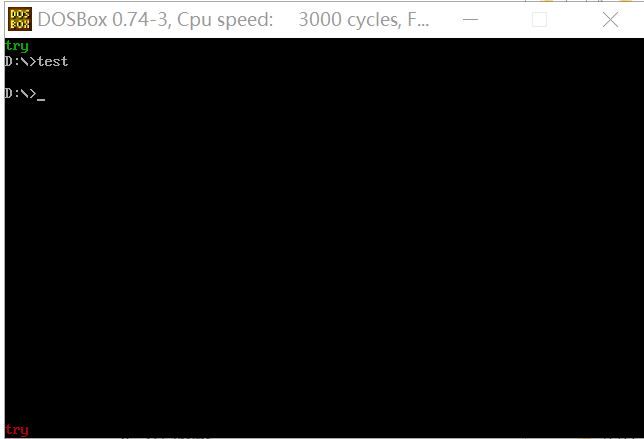
5. Experimental task 5
For 8086 CPU, for 8086 CPU, the known logical segment is defined as follows: at 80 × In 25 color character mode, the student number is displayed in the middle of the last line of the screen. It is required that the student number and broken lines on both sides of the output window are displayed in white foreground.
Note *:
1. 80 × 25 color character mode display buffer structure, see the description in the textbook "experiment 9 programming according to materials".
2. When writing the program, replace the student number of the data segment with your own student number.
assume cs:code,ds:data data segment str db '201983290287' len equ $ - str;12 Characters data ends code segment start: mov ax,data mov ds,ax mov ax,0b800h mov es,ax mov cx,0F9Fh mov bx,0 s1: mov ah,17h;White characters on blue background mov al,' ';Blue screen mov es:[bx],ax add bx,2 loop s1 mov bx,0F00h mov cx,34;A line has 80 characters, accounting for 160 bytes-12/2=34,Achieve centering s2: mov al,'-' mov es:[bx],ax add bx,2 loop s2 mov cx,len mov si,0 s3: mov al,[si] inc si mov es:[bx],ax add bx,2 loop s3 mov cx,34 s4: mov al,'-' mov es:[bx],ax add bx,2 loop s4 mov ax,4c00h int 21h code ends end
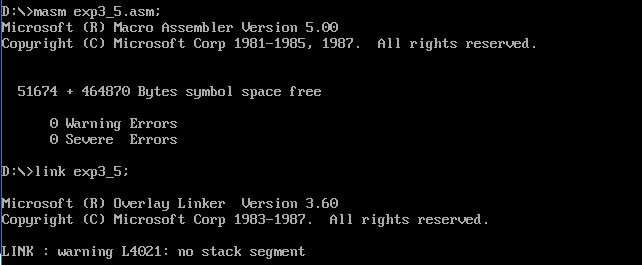
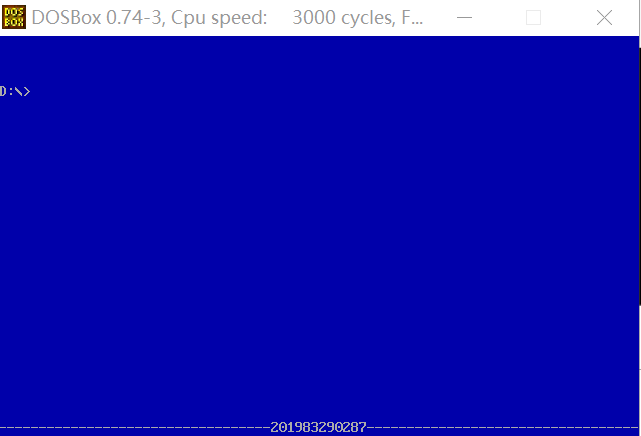
5, Experimental summary
Using subroutines is more concise